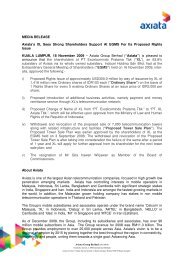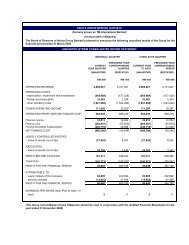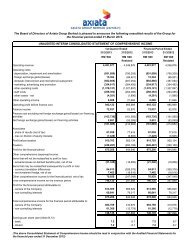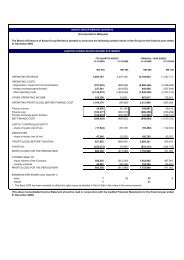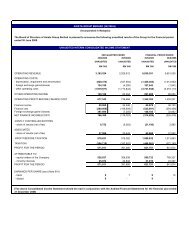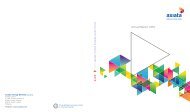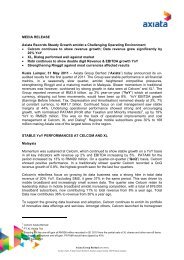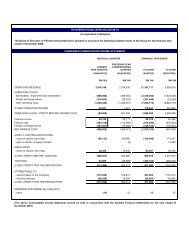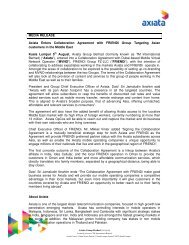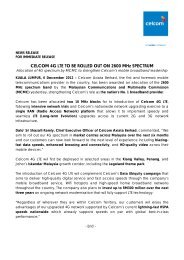- Page 7:
Corporate InformationGROUP COMPANY
- Page 10 and 11:
Axiata Group Berhad • 010Tan Sri
- Page 12 and 13:
Chairman’s StatementI am pleased
- Page 14 and 15:
Chairman’s Statement3 The World B
- Page 16 and 17:
Chairman’s StatementDato’ Sri J
- Page 18 and 19:
President & GCEO’s Business Revie
- Page 20 and 21:
O P E R A T I N G C O M P A N I E S
- Page 22 and 23:
President & GCEO’s Business Revie
- Page 24 and 25:
President & GCEO’s Business Revie
- Page 26 and 27:
Reporting byGeographical LocationMA
- Page 28 and 29:
Simplified GroupBalance SheetTotal
- Page 30 and 31:
Major Milestones1994February 1994A
- Page 32 and 33:
Major Milestones2007June 2007Indoce
- Page 34 and 35:
Axiata GalleryAxiata Group Berhad
- Page 36 and 37:
Awards & AccoladesAxiata Group Berh
- Page 38 and 39:
Feature article:The Future of Mobil
- Page 41 and 42:
Strengthin DiversityDiversity is ke
- Page 43 and 44:
Axiata’s vision is to be a region
- Page 45 and 46:
Major Associates/AffiliatesINDIAIDE
- Page 47 and 48:
24.42%Samart I-Mobile PublicCompany
- Page 49 and 50:
From left to right:Dato’ Sri Jama
- Page 51 and 52:
Dato’ Sri Jamaludin IbrahimAge 51
- Page 53 and 54:
Datuk Azzat KamaludinAge 64, Malays
- Page 55 and 56:
Dr. Farid Mohamed SaniAge 34, Malay
- Page 57 and 58:
From left to right:Dr Hans Wijayasu
- Page 59 and 60:
Suryani HusseinGroup Company Secret
- Page 61 and 62:
04Michael KuehnerManaging Director
- Page 63 and 64:
Profile of Operating Companies’ M
- Page 65 and 66:
THE BOARD OF DIRECTORSRole and Resp
- Page 67 and 68:
Statement on Corporate GovernanceAx
- Page 69 and 70:
Where any direction or decision is
- Page 71 and 72:
Statement on Corporate GovernanceAm
- Page 73 and 74:
Board CommitteesFour standing Board
- Page 75 and 76:
Statement on Corporate GovernanceES
- Page 77 and 78:
In ensuring fairness and promoting
- Page 79 and 80:
INTRODUCTIONPursuant to Paragraph 1
- Page 81 and 82:
Statement on Internal Control1.2 Bo
- Page 83 and 84:
A process was introduced in 2009 to
- Page 85 and 86:
Statement on Internal Control3.3 Re
- Page 87 and 88:
Risks Identified by The GroupAPPEND
- Page 89 and 90:
The Board of Directors of Axiata is
- Page 91 and 92:
Others• Reviewed and approved Axi
- Page 93 and 94:
Board Audit Committee Reportiii)iv)
- Page 95 and 96:
iii)iv)Discuss problems and reserva
- Page 97 and 98:
Board Audit Committee Reportvii) Re
- Page 99 and 100:
7.0 REVIEW & EVALUATION PROCEDURES
- Page 101:
Subscriptions by TechnologYReported
- Page 104 and 105:
Business ReviewAbout CelcomCelcom i
- Page 106 and 107:
Business ReviewREVENUERM (Billion)E
- Page 108 and 109:
EBITDA (RM Million)+ 14.3%+ 6.0%+ 1
- Page 110 and 111:
Celcom SuksesPrabayar Celcom Sukses
- Page 112 and 113:
Business ReviewAbout XLXL, which st
- Page 114 and 115:
REVENUEIDR (Billion)EBITDAIDR (Bill
- Page 116 and 117:
EBITDA (IDR Billion)+ 92.5%+ 17.5%+
- Page 118 and 119:
Business ReviewAbout DIALOGDialog i
- Page 120 and 121:
REVENUESLR (Billion)EBITDASLR (Bill
- Page 122 and 123:
EBITDA (SLR Million)+ > 100%+ 19.3%
- Page 124 and 125:
Business ReviewAbout ROBIRobi is a
- Page 126 and 127:
REVENUEBDT (Billion)EBITDABDT (Bill
- Page 128 and 129:
Business ReviewABOUT HELLOA pioneer
- Page 130 and 131:
REVENUEUSD (Million)EBITDAUSD (Mill
- Page 132 and 133:
Business ReviewABOUT IDEAIdea is a
- Page 134 and 135:
REVENUEINR (Billion)EBITDAINR (Bill
- Page 136 and 137: Business ReviewABOUT M1M1 is a lead
- Page 138 and 139: REVENUESGD (Million)EBITDASGD (Mill
- Page 140 and 141: PAKISTANMULTINET PAKISTAN(PRIVATE)
- Page 142 and 143: Feature article:Mobile App Storesa
- Page 145 and 146: AdvancingAsiaAxiata is committed to
- Page 147 and 148: Axiata provides affordableand innov
- Page 149 and 150: Talent AttractionAxiata is also tak
- Page 151 and 152: Corporate ResponsibilityCommunity P
- Page 153 and 154: XL also collaborated with ICT Watch
- Page 155 and 156: 156 Directors’ Responsibility Sta
- Page 157 and 158: Directors’ ReportThe Directors ha
- Page 159 and 160: EMPLOYEES SHARE OPTIONS SCHEME (“
- Page 161 and 162: Directors’ ReportDIRECTORS’
- Page 163 and 164: Income StatementsFOR THE FINANCIAL
- Page 165 and 166: Balance SheetsAS AT 31 DECEMBER 200
- Page 167 and 168: Consolidated Statement of Changes i
- Page 169 and 170: Cash Flow StatementsFOR THE FINANCI
- Page 171 and 172: 3. BASIS OF PREPARATION OF THE FINA
- Page 173 and 174: Notes to the Financial StatementsFO
- Page 175 and 176: 3. BASIS OF PREPARATION OF THE FINA
- Page 177 and 178: Notes to the Financial StatementsFO
- Page 179 and 180: 4 SIGNIFICANT ACCOUNTING POLICIES (
- Page 181 and 182: Notes to the Financial StatementsFO
- Page 183 and 184: 4. SIGNIFICANT ACCOUNTING POLICIES
- Page 185: Notes to the Financial StatementsFO
- Page 189 and 190: Notes to the Financial StatementsFO
- Page 191 and 192: 4. SIGNIFICANT ACCOUNTING POLICIES
- Page 193 and 194: Notes to the Financial StatementsFO
- Page 195 and 196: 5. CRITICAL ACCOUNTING ESTIMATES AN
- Page 197 and 198: Notes to the Financial StatementsFO
- Page 199 and 200: 6. SIGNIFICANT GROUP RESTRUCTURING,
- Page 201 and 202: Notes to the Financial StatementsFO
- Page 203 and 204: 8(c) DIRECTORS’ REMUNERATIONGroup
- Page 205 and 206: Notes to the Financial StatementsFO
- Page 207 and 208: 13. SHARE CAPITALGroupCompany2009 2
- Page 209 and 210: Notes to the Financial StatementsFO
- Page 211 and 212: 14. EMPLOYEES’ SHARE OPTION SCHEM
- Page 213 and 214: Notes to the Financial StatementsFO
- Page 215 and 216: 14. EMPLOYEES’ SHARE OPTION SCHEM
- Page 217 and 218: Notes to the Financial StatementsFO
- Page 219 and 220: 14. EMPLOYEES’ SHARE OPTION SCHEM
- Page 221 and 222: Notes to the Financial StatementsFO
- Page 223 and 224: 16. BORROWINGS (CONTINUED)2009 2008
- Page 225 and 226: Notes to the Financial StatementsFO
- Page 227 and 228: 18. AMOUNTS DUE FROM/(TO) SUBSIDIAR
- Page 229 and 230: Notes to the Financial StatementsFO
- Page 231 and 232: 21. INTANGIBLE ASSETS (CONTINUED)(a
- Page 233 and 234: Notes to the Financial StatementsFO
- Page 235 and 236: 22. PROPERTY, PLANT AND EQUIPMENT (
- Page 237 and 238:
Notes to the Financial StatementsFO
- Page 239 and 240:
24. PREPAID LEASE PAYMENTS (CONTINU
- Page 241 and 242:
Notes to the Financial StatementsFO
- Page 243 and 244:
27. ASSOCIATES (CONTINUED)(ii)Axiat
- Page 245 and 246:
Notes to the Financial StatementsFO
- Page 247 and 248:
30. INVENTORIESGroup2009 2008RM’0
- Page 249 and 250:
Notes to the Financial StatementsFO
- Page 251 and 252:
34. CASH FLOWS FROM/(USED IN) OPERA
- Page 253 and 254:
Notes to the Financial StatementsFO
- Page 255 and 256:
35. CONTINGENCIES AND COMMITMENTS (
- Page 257 and 258:
Notes to the Financial StatementsFO
- Page 259 and 260:
36. HEDGING TRANSACTIONS (CONTINUED
- Page 261 and 262:
Notes to the Financial StatementsFO
- Page 263 and 264:
40. SEGMENTAL REPORTING (CONTINUED)
- Page 265 and 266:
Notes to the Financial StatementsFO
- Page 267 and 268:
41. FINANCIAL RISK MANAGEMENT OBJEC
- Page 269 and 270:
Notes to the Financial StatementsFO
- Page 271 and 272:
42. INTEREST RATE RISK (CONTINUED)M
- Page 273 and 274:
Notes to the Financial StatementsFO
- Page 275 and 276:
45. LIST OF SUBSIDIARIESThe subsidi
- Page 277 and 278:
Notes to the Financial StatementsFO
- Page 279 and 280:
45. LIST OF SUBSIDIARIES (CONTINUED
- Page 281 and 282:
Notes to the Financial StatementsFO
- Page 283 and 284:
48. RELATED PARTY TRANSACTIONS (CON
- Page 285 and 286:
Statement by DirectorsPURSUANT TO S
- Page 287 and 288:
Independent Auditors’ ReportTO TH
- Page 289 and 290:
OPERATING COSTSFor FY09 the Group
- Page 291 and 292:
Intangible AssetsIntangible assets
- Page 293 and 294:
DIRECTORS’ DIRECT AND INDIRECT IN
- Page 295 and 296:
Shareholding StatisticsAS AT 30 APR
- Page 297 and 298:
No.Compliance Issue6. VARIATION IN
- Page 299 and 300:
TransactingCompaniesTransactingRela
- Page 301 and 302:
List of Top Ten PropertiesAS AT 31
- Page 303 and 304:
Glossary3GThe third generation of m
- Page 305 and 306:
LOALimits of AuthorityLTELong Term
- Page 307 and 308:
Notice ofAnnual General MeetingNOTI
- Page 309 and 310:
Notice of Annual General MeetingNot
- Page 311 and 312:
AdministrativeDetails for the 18thA
- Page 313 and 314:
Proxy Form(Before completing the fo



